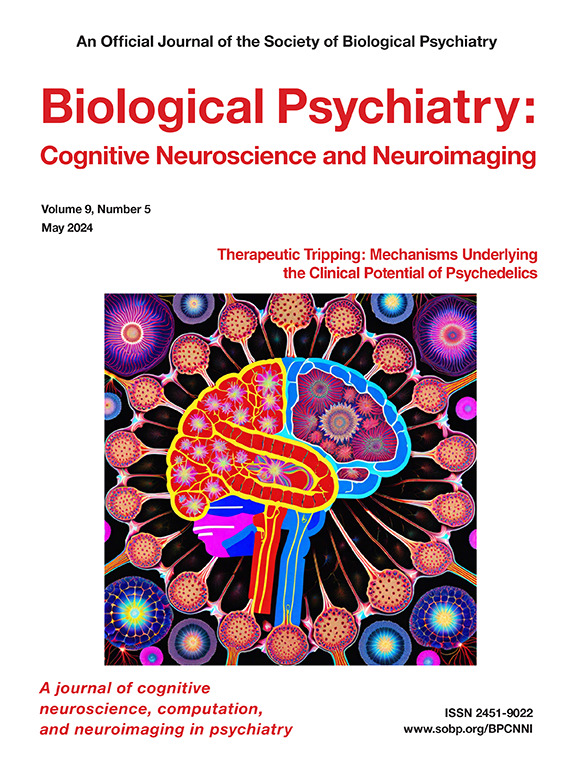Neurophysiological Pathways of Unconscious Emotion Processing in Depression: Insights From a Simultaneous Electroencephalography–Functional Magnetic Resonance Imaging Measurement
IF 5.7
2区 医学
Q1 NEUROSCIENCES
Biological Psychiatry-Cognitive Neuroscience and Neuroimaging
Pub Date : 2024-11-01
DOI:10.1016/j.bpsc.2024.07.005
引用次数: 0
Abstract
Background
Major depressive disorder (MDD) is characterized by strong emotional dysregulation. Mechanisms driving the negative affect in depression may be fast processes existing on an unconscious level.
Methods
A priming task was conducted using simultaneous electroencephalography–functional magnetic resonance imaging measurement involving presentation of facial expressions (happy, sad, and neutral) to examine the neurophysiological pathway of biased unconscious emotion processing in MDD. Priming prior to a target emotion created unconscious (16.7-ms primer) and conscious (150-ms primer) trials. A large sample (N = 126) was recruited, containing healthy control participants (n = 66; 37 women) and participants with MDD (n = 60; 31 women).
Results
The healthy control group showed a shorter reaction time in happy but not in sad or neutral trials compared with the MDD group. N170 amplitudes were lower in trials with unconscious than conscious primer presentation. N170 amplitudes correlated with cortical (right fusiform gyrus, right middle temporal gyrus, right inferior temporal gyrus, left supplementary motor area, right middle frontal gyrus) and subcortical brain regions (right amygdala). The strength of N170 and brain activity correlation increased when the stimulus was consciously presented. Presented emotions did not affect the correlation of N170 values and brain activity.
Conclusions
Our findings show that MDD may exhibit biased emotion regulation abilities at a behavioral and neurophysiological level. Face-sensitive event-related potentials demonstrate a correlation with heightened brain activity in regions associated with both face recognition (fusiform gyrus) and emotion processing (amygdala). These findings are evident in both MDD and healthy control groups, with lower effect sizes in the MDD group indicating reduced emotion recognition and processing abilities.
抑郁症患者无意识情绪处理的神经生理学途径:脑电图-核磁共振成像同步测量的启示。
背景:重度抑郁障碍(MDD)的特点是强烈的情绪失调。驱动抑郁症负面情绪的机制可能是存在于无意识层面的快速过程:方法:通过同时测量脑电图-核磁共振成像(EEG-FMRI)和面部表情(快乐、悲伤、中性)来进行引物任务,以研究 MDD 中偏向无意识情绪处理的神经生理学途径。在目标情绪之前的引物会产生无意识(16.7 毫秒引物)和有意识(150 毫秒引物)试验。研究人员招募了一个 N = 126 的大样本,其中包括健康对照组(HC;n = 66;37 名女性)和 MDD(n = 60;31 名女性):结果:与 MDD 相比,HC 在快乐试验中的反应时间较短,但在悲伤或中性试验中的反应时间较短。在无意识引物呈现的试验中,N170振幅低于有意识引物呈现的试验。N170振幅与皮层(右侧纺锤形回(FFG)、右侧颞中回、右侧颞下回、左侧辅助运动区、右侧额中回)和皮层下脑区(右侧杏仁核)相关。当有意识地呈现刺激时,N170 和大脑活动相关性的强度会增加。呈现的情绪并不影响N170值与大脑活动的相关性:我们的研究结果表明,MDD可能在行为和神经生理学水平上表现出有偏差的情绪调节能力。对人脸敏感的事件相关电位显示,与人脸识别(FFG)和情绪处理(杏仁核)相关区域的大脑活动增强具有相关性。这些发现在 MDD 和 HC 中都很明显,MDD 的效应大小较低,表明情绪识别和处理能力下降。
本文章由计算机程序翻译,如有差异,请以英文原文为准。
求助全文
约1分钟内获得全文
求助全文
来源期刊

Biological Psychiatry-Cognitive Neuroscience and Neuroimaging
Neuroscience-Biological Psychiatry
CiteScore
10.40
自引率
1.70%
发文量
247
审稿时长
30 days
期刊介绍:
Biological Psychiatry: Cognitive Neuroscience and Neuroimaging is an official journal of the Society for Biological Psychiatry, whose purpose is to promote excellence in scientific research and education in fields that investigate the nature, causes, mechanisms, and treatments of disorders of thought, emotion, or behavior. In accord with this mission, this peer-reviewed, rapid-publication, international journal focuses on studies using the tools and constructs of cognitive neuroscience, including the full range of non-invasive neuroimaging and human extra- and intracranial physiological recording methodologies. It publishes both basic and clinical studies, including those that incorporate genetic data, pharmacological challenges, and computational modeling approaches. The journal publishes novel results of original research which represent an important new lead or significant impact on the field. Reviews and commentaries that focus on topics of current research and interest are also encouraged.
 求助内容:
求助内容: 应助结果提醒方式:
应助结果提醒方式:


